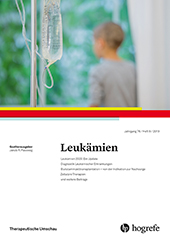Akute Lymphoblastische Leukämie – Diagnostik und Therapie
Abstract
Zusammenfassung. Die Akute Lymphoblastische Leukämie (ALL) ist eine seltene maligne, hämatologische Erkrankung. Der Häufigkeitsgipfel liegt im Kindesalter und ist im Erwachsenenalter selten; was eine Therapie in qualifizierten Zentren unabdingbar macht. Das klinische Bild der ALL ist charakterisiert durch die Proliferation und Akkumulation maligner unreifer lymphatischer Blasten in Knochenmark, Blut, lymphatischem und nicht-lymphatischem Gewebe. Unbehandelt führt die Erkrankung innerhalb weniger Monate zum Tod. Die ALL ist eine sehr heterogene Erkrankung. Die Prognose wird bestimmt durch den Immunphänotyp, Zytogenetik und molekulare Marker, welche Einfluss auf die therapeutische Strategie und Therapieintensität haben. Das Ziel der Therapie bei jungen Patienten ist kurativ. Patienten sollten nach internationalen Studien-Gruppen Protokollen behandelt werden. Das Gesamtüberleben hat sich im letzten Jahrzehnt verbessert; was auch mit der Einführung neuer «targeted drugs» zusammenhängt. Zusätzlich gab es neue Entwicklungen zur Bestimmung der minimalen / messbaren Resterkrankung (MRD), welche einen starken Einfluss auf die Entscheidung zur allogenen hämatopoietischen Stammzell-Transplantation hat.
Abstract. Acute lymphoblastic leukemia (ALL) is a rare malignant hematological disease. The incidence of the disease peaks in the childhood and thus is rare in adults, making assessment and care at qualified centers highly desirable. Clinically, ALL presents with the proliferation and accumulation of malignant, immature lymphatic blasts in the bone marrow, peripheral blood, and lymphatic and non-lymphatic tissue. Untreated, ALL results in death within few months. ALL is a heterogeneously disease. Prognosis is determined by immunophenotype, cytogenetics and molecular markers which influences therapeutic strategies. The aim of therapy in younger patients is curative. Patients should be treated in international study group protocols. Overall survival has improved over the last decade; also with the introduction of new targeted therapies. In addition, there have been recent developments in minimal / measurable residual disease (MRD) determination, which has a strong impact on the decision for an allogeneic hematopoietic stem cell transplantation.



